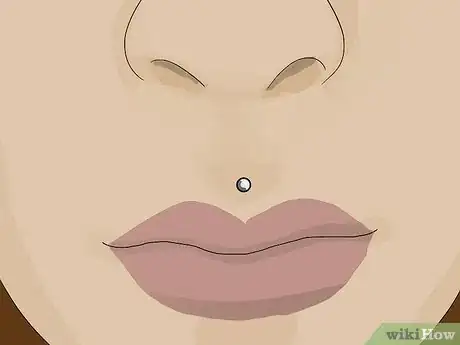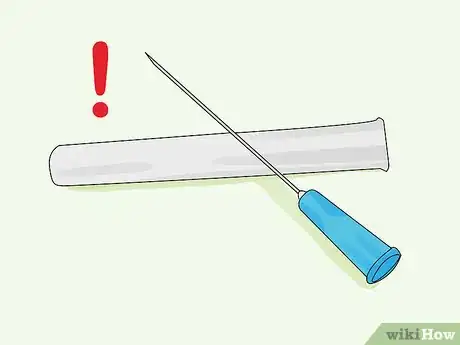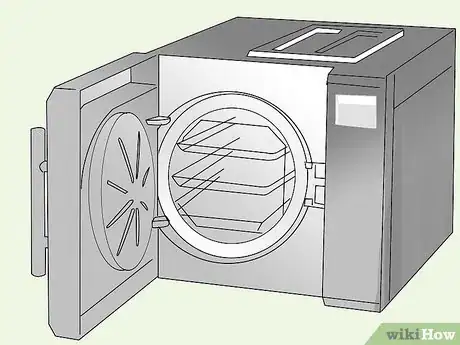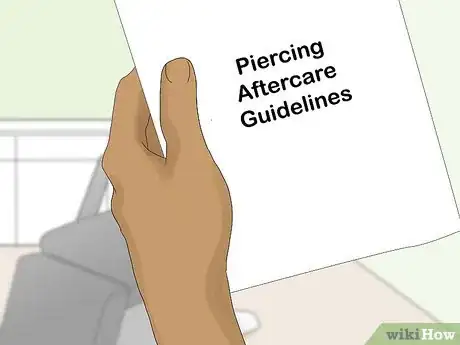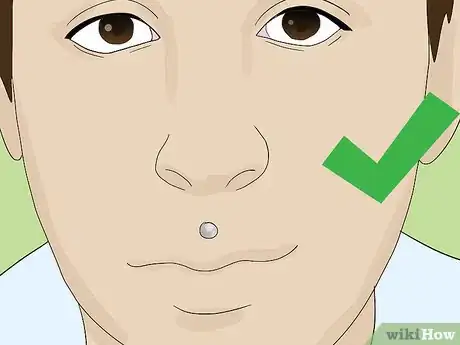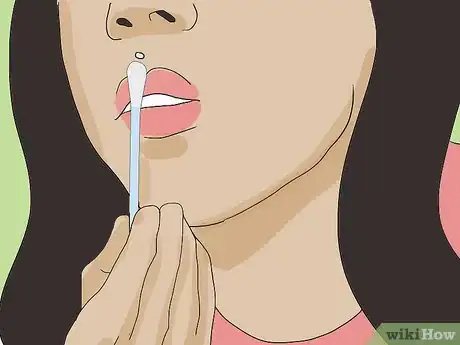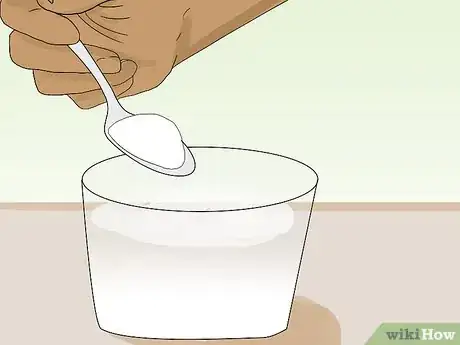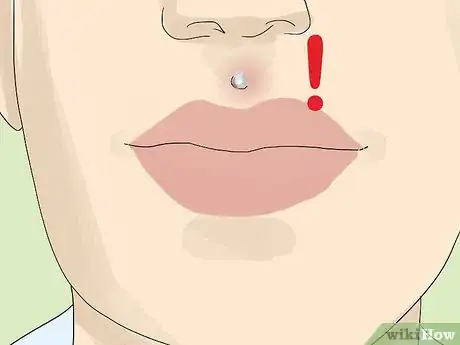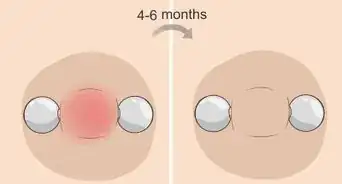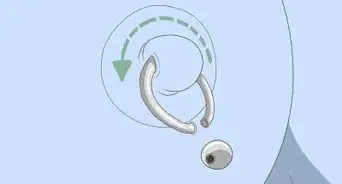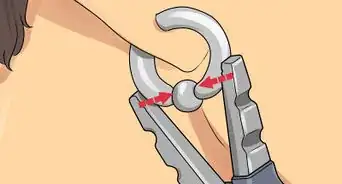This article was co-authored by Karissa Sanford. Karissa Sanford is the Co-owner of Make Me Holey Body Piercing, a piercing studio based in the San Francisco Bay Area that specializes in safe and friendly body piercing. Karissa has over 10 years of piercing experience and is a member of the Association of Professional Piercers (APP).
This article has been viewed 30,591 times.
A medusa piercing can be an exciting, edgy, and unique piercing to add to your look. It's a piercing found just above the lip that can work on its own or when paired with other piercings. To get a medusa piercing, decide on the basics in terms of location and jewelry. Then, find a quality piercer to administer the piercing. When it's all done, care for your piercing so you can enjoy your new look.
Steps
Deciding on the Basics
-
1Familiarize yourself with medusa piercings. Medusa piercings are usually a single stud piercing found in the center of the lip just above the lip line. A medusa piercing would be found on the flesh just above your lip and below your nose. This is a very noticeable piercing, so it's hard to hide or minimize. However, if you want a bold look, it can be a great choice.[1]
-
2Decide if you want to incorporate other piercings. Medusa piercings are usually a single piercing. However, some people enjoy adding other piercings to a medusa piercing to add variety. It's often paired with other piercings of the lip or nose for a striking look.[2]
- For example, some people prefer to pair a medusa piercing with an additional piercing on the upper lip itself, near the center. The end product is a piercing that makes two dots running down your mouth.
- Other people enjoy pairing a medusa piercing with a nose ring. Septum piercings, in particular, are popular to pair with medusa piercings.
- If you have existing piercings, think about how these would look with a medusa piercing before committing to one. You want to make sure a medusa piercing blends easily with the rest of your style.
Advertisement -
3Choose your jewelry type. Only hypoallergenic jewelry made from surgical stainless steel, gold, platinum, niobium, or titanium should be used. Traditionally, studs or balls are used in medusa piercings. However, some people do use hoop jewelry instead. You can choose whichever you prefer.[3]
- In addition to the type of jewelry you choose, think about the colors or materials you prefer. For example, if you wear a lot of colorful outfits, you may want to go for a neutral-colored piercing so it will go with most of your wardrobe.[4]
-
4Consider the cost. Make sure a medusa piercing is within your budget. Check the average prices for studios in your area. When checking prices, ask about prices for a medusa piercing specifically. Some studios may charge more for certain types of piercings.
- You should also account for costs in addition to the piercing itself. How much does the jewelry you want cost? How much does it cost to buy supplies for aftercare? Take these questions into consideration when evaluating the cost of a medusa piercing.
-
5Make sure your piercing is safe for work or school. A medusa piercing is a very bold piercing and not the easiest to hide. Before deciding on a medusa piercing, make sure it's okay for your place of work or your school. Check dress codes carefully as, once you get a medusa piercing, you will not be able to conceal it from others.
Getting Your Piercing Done at a Safe Studio
-
1Find a clean space.[5] Visit a studio before making an appointment to make sure the space is clean. You do not want to risk infection by getting a piercing done in an untidy studio. When visiting a piercing studio, look things over closely to make sure the atmosphere is hygienic.
- Make sure the studio smells clean and that you do not notice dust, dirt, or grime anywhere, including the bathroom.
- You should also ask about how often the space is cleaned and sanitized. Good studios will be professionally cleaned at least once a day.
-
2Ask if the shop uses sterile needles. A quality studio uses a new, sterile needle for every customer. Needles are then disposed after a piercing is done. If the shop uses anything other than single-use sterile piercing needles, take your business elsewhere.
- Piercing guns should not be used at all because they cannot be properly sterilized.
- The piercer should also wash their hands before putting on fresh gloves for each client. Make sure they change their gloves if they touch anything other than the sterile equipment, like a phone or pen.
-
3Make sure the shop operates legally. Any studio you work with should have a license to operate and a health certificate hung in plain sight. They should also require age verification before administering piercings. You should not trust a piercing studio that operates illegally.
-
4Look for highly trained piercers. Ask what kind of training the piercer has and where it was done. You want a piercer that is highly educated and trained, no one that is self-taught. If the piercer is licensed, it means they’ve been specially trained and are the best choice for your piercing.[6]
-
5Check out their autoclave. Ask to see the autoclave before booking your appointment. An autoclave is a device used to sterilize jewelry and tools with high heat before a piercing. A reputable studio will have a clean, working autoclave that they use for every piercing. Also ask how equipment that can’t be put in the autoclave is sterilized—they should be disinfected after every use with a commercial bleach or disinfectant.
- Do not book a piercing at a studio without an autoclave. Some studios use dry heating or boiling to sterilize jewelry, but this is not a sufficient means to kill bacteria that could cause infections.
-
6Choose a studio that provides aftercare guidelines. A good piercer wants you to have as smooth an experience as possible in their studio. Ask if you'll be provided information and supplies for aftercare. The ideal studio will give you detailed instructions for aftercare and also provide you with some of the supplies you'll need.[7]
-
7Prepare for your piercing. Make sure you are up to date on your Hepatitis B and Tetanus vaccinations before getting a piercing. Other than that, practice good oral hygiene leading up the piercing. You should also find someone to use as an emergency contact in case something goes wrong.[8]
- It's a good idea to find someone to bring with you. This can help in case you get nervous as you'll have a friend or family member to lean on.
-
8Get your piercing done. At the studio, the piercing artist will make a mark above your lip where the piercing will go. They will then pierce your skin with a sterilized needle. While there will be some pain, it is momentary. Many people are surprised that the piercing was not as painful as expected.
- A piercer should never use a piercing gun to give you a piercing, regardless of the location.
Caring for your Piercing
-
1Follow the advice of your piercer carefully. It’s important to follow their advice to reduce the risk of infection or rejection and promote healing.[9] Every piercing is different, but your piercer can give you specific recovery advice based on how your piercing went. Before leaving the studio, talk over aftercare with your piercer carefully and make sure you leave without any questions unanswered.[10]
- Ask important questions to know, such as, "How often should I clean my piercing?" and "What can I do to prevent an infection?"
-
2Clean your piercing after every meal or snack and before bed. You’ll need to clean the area and the surrounding jewelry several times a day. Wash your hands and then use warm salt water or an antibacterial, alcohol-free mouthwash to clean the piercing.[11]
-
3Do regular sea salt soaks. Sea salt soaks help soothe pain and irritation and promote healing. Dissolve about an eighth a teaspoon of sea salt in warm water. Then, soak your piercing in the solution for five minutes.
- If it's uncomfortable to submerge your piercing in water for five minutes, soak a cotton ball in the solution and press that to your piercing for five minutes.
-
4Take action to reduce the risk of infection. Rinse your mouth after eating, drinking, or smoking to avoid infection. When brushing your teeth, be very gentle when you brush around the piercing. Avoid touching your piercing unless it's absolutely necessary.[12] Avoid kissing anyone while you heal (to avoid their saliva) and do not share cups, plates, forks, knives, or spoons. Avoid spicy, salty, or acidic foods and drinks in addition to hot drinks, like coffee, tea, or hot chocolate.[13]
-
5Seek care for an infected piercing. Signs of infection include increased pain, swelling, redness or warmth in the area, drainage of pus, fever, and/or red streaks extending from the area.[14] If you notice signs of an infection, contact your healthcare provider immediately for guidance. Do not attempt to treat an infection on your own. Follow professional advice to get the infection treated quickly and effectively.
Expert Q&A
-
QuestionHow do you prevent infection?
 Karissa SanfordKarissa Sanford is the Co-owner of Make Me Holey Body Piercing, a piercing studio based in the San Francisco Bay Area that specializes in safe and friendly body piercing. Karissa has over 10 years of piercing experience and is a member of the Association of Professional Piercers (APP).
Karissa SanfordKarissa Sanford is the Co-owner of Make Me Holey Body Piercing, a piercing studio based in the San Francisco Bay Area that specializes in safe and friendly body piercing. Karissa has over 10 years of piercing experience and is a member of the Association of Professional Piercers (APP).
Body Piercing Specialist Wash your hands thoroughly before cleaning. Handling your piercing with dirty hands can cause an infection.
Wash your hands thoroughly before cleaning. Handling your piercing with dirty hands can cause an infection.
Warnings
- Oral piercings have risks, which is why the American Dental Association warns against getting these types of piercings. Some of the risks include: drooling; damage to your tongue, gums or fillings; difficulty speaking, chewing or swallowing; serious or chronic infection due to the bacteria in the mouth; allergic reaction to the metal in the jewelry; and serious health problems such as bleeding, gum disease, and hepatitis B and C.[15]⧼thumbs_response⧽
References
- ↑ http://www.zarias.com/medusa-piercings/
- ↑ http://www.zarias.com/medusa-piercings/
- ↑ http://www.zarias.com/medusa-piercings/
- ↑ Karissa Sanford. Body Piercing Specialist. Expert Interview. 29 October 2019.
- ↑ Karissa Sanford. Body Piercing Specialist. Expert Interview. 29 October 2019.
- ↑ https://www.webmd.com/oral-health/guide/oral-piercing#1
- ↑ https://www.webmd.com/oral-health/guide/oral-piercing#1
- ↑ https://www.uhs.umich.edu/bodyart
- ↑ Karissa Sanford. Body Piercing Specialist. Expert Interview. 29 October 2019.
- ↑ https://www.webmd.com/oral-health/guide/oral-piercing#1
- ↑ https://www.webmd.com/oral-health/guide/oral-piercing#2
- ↑ Karissa Sanford. Body Piercing Specialist. Expert Interview. 29 October 2019.
- ↑ https://www.webmd.com/oral-health/guide/oral-piercing#2
- ↑ https://www.webmd.com/skin-problems-and-treatments/symptoms-of-infection-after-a-skin-injury
- ↑ https://www.webmd.com/oral-health/guide/oral-piercing#1
